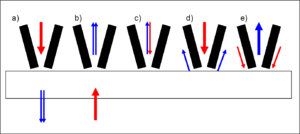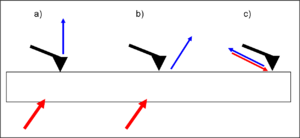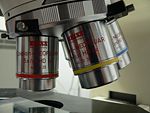- Near-field scanning optical microscope
-
Near-field scanning optical microscopy (NSOM/SNOM) is a microscopic technique for nanostructure investigation that breaks the far field resolution limit by exploiting the properties of evanescent waves. This is done by placing the detector very close (distance much smaller than wavelength λ) to the specimen surface. This allows for the surface inspection with high spatial, spectral and temporal resolving power. With this technique, the resolution of the image is limited by the size of the detector aperture and not by the wavelength of the illuminating light. In particular, lateral resolution of 20 nm and vertical resolution of 2–5 nm have been demonstrated.[1] As in optical microscopy, the contrast mechanism can be easily adapted to study different properties, such as refractive index, chemical structure and local stress. Dynamic properties can also be studied at a sub-wavelength scale using this technique.
NSOM/SNOM is a form of scanning probe microscopy.
Contents
History
Edward Hutchinson Synge, a scientist, is given credit for conceiving and developing the idea for an imaging instrument that would image by exciting and collecting diffraction in the near field. His original idea, proposed in 1928, was based upon the usage of intense nearly planar light from an arc under pressure behind a thin, opaque metal film with a small orifice of about 100 nm. The orifice was to remain within 100 nm of the surface, and information was to be collected by point-by-point scanning. He foresaw the illumination and the detector movement being the biggest technical difficulties.[2][3][4] John A. O'Keefe also developed similar theories in 1956. He thought the moving of the pinhole or the detector when it is so close to the sample would be the most likely issue that could prevent the realization of such an instrument.[5] It was Ash and Nicholls who, in 1972, first broke the Abbe’s diffraction limit using radiation with wavelength of 3 cm. A line grating was resolved with a resolution of λ0/60.[6] It was twelve more years before the first papers that used visible radiation for near field scanning were published by Pohl et al., and Lewis et al. Both these works involved the use of a subwavelength metal coated optical aperture at the tip of a sharp pointed probe, and a feedback mechanism to maintain a constant distance of a few nanometers between the sample and the probe.[7] Resolution as low as 25 nm (about λ0/20) was achieved.[8]
Theory
According to Abbe’s theory of image formation, developed in 1873, the resolving capability of an optical component is ultimately limited by the spreading out of each image point due to diffraction. Unless the aperture of the optical component is large enough to collect all the diffracted light, the finer aspects of the image will not correspond exactly to the object. The minimum resolution (d) for the optical component are thus limited by its aperture size, and expressed by the Rayleigh criterion:
Here, λ0 is the wavelength in vacuum; NA is the numerical aperture for the optical component (maximum 1.3–1.4 for modern objectives with a very high magnification factor). Thus, the resolution limit is usually around λ0/2 for conventional optical microscopy.[9]
This treatment only assumes the light diffracted into the far-field that propagates without any restrictions. NSOM makes use of evanescent or non propagating fields that exist only near the surface of the object. These fields carry the high frequency spatial information about the object and have intensities that drop off exponentially with distance from the object. Because of this, the detector must be placed very close to the sample in the near field zone, typically a few nanometers. As a result, near field microscopy remains primarily a surface inspection technique. The detector is then rastered across the sample using a piezoelectric stage. The scanning can either be done at a constant height or with regulated height by using a feedback mechanism.[10]
Modes of operation
Aperture and apertureless operation
 Sketch of a) typical metal-coated tip, and b) sharp uncoated tip.[11]
Sketch of a) typical metal-coated tip, and b) sharp uncoated tip.[11]
There exist NSOM which can be operated in so-called aperture mode and NSOM for operation in a non-aperture mode. As illustrated, the tips used in the apertureless mode are very sharp and do not have a metal coating.
Though there are many issues associated with the apertured tips (heating, artifacts, contrast, sensitivity, topology and interference amongst others), aperture mode remains more popular. This is primarily because apertureless mode is even more complex to set up and operate, and is not understood as well. There are five primary modes of apertured NSOM operation and four primary modes of apertureless NSOM operation. The major ones are illustrated in the next figure.
 Apertured modes of operation: a) illumination, b) collection, c) illumination collection, d) reflection and e) reflection collection.[12]
Apertured modes of operation: a) illumination, b) collection, c) illumination collection, d) reflection and e) reflection collection.[12]
 Apertureless modes of operation: a) photon tunneling (PSTM) by a sharp transparent tip, b) PSTM by sharp opaque tip on smooth surface, and c) scanning interferometric apertureless microscopy with double modulation.[11]
Apertureless modes of operation: a) photon tunneling (PSTM) by a sharp transparent tip, b) PSTM by sharp opaque tip on smooth surface, and c) scanning interferometric apertureless microscopy with double modulation.[11]
Feedback mechanisms
Feedback mechanisms are usually used to achieve high resolution and artifact free images since the detector must be positioned within a few nanometers of the surfaces. Some of these mechanisms are:
- Constant force feedback: This mode is very similar to the feedback mechanism used in atomic force microscope (AFM). Experiments can be performed in contact, intermittent contact, and non-contact modes.
- Shear force feedback: In this mode, a tuning fork is mounted alongside the tip and made to oscillate at its resonance frequency. The amplitude is closely related to the tip-surface distance, and thus used as a feedback mechanism.[10]
Contrast
It is possible to take advantage of the various contrast techniques available to optical microscopy though NSOM but with much higher resolution. By using the change in the polarization of light or the intensity of the light as a function of the incident wavelength, it is possible to make use of contrast enhancing techniques such as staining, fluorescence, phase contrast and differential interference contrast. It is also possible to provide contrast using the change in refractive index, reflectivity, local stress and magnetic properties amongst others.[10][11]
Instrumentation and standard setup
 Block diagram of an apertureless reflection-back-to-the-fiber NSOM setup with shear-force distance control and cross-polarization; 1: beam splitter and crossed polarizers; 2: shear-force arrangement; 3: sample mount on a piezo stage.[12]
Block diagram of an apertureless reflection-back-to-the-fiber NSOM setup with shear-force distance control and cross-polarization; 1: beam splitter and crossed polarizers; 2: shear-force arrangement; 3: sample mount on a piezo stage.[12]
The primary components of an NSOM setup are the light source, feedback mechanism, the scanning tip, the detector and the piezoelectric sample stage. The light source is usually a laser focused into an optical fiber through a polarizer, a beam splitter and a coupler. The polarizer and the beam splitter would serve to remove stray light from the returning reflected light. The scanning tip, depending upon the operation mode, is usually a pulled or stretched optical fiber coated with metal except at the tip or just a standard AFM cantilever with a hole in the center of the pyramidal tip. Standard optical detectors, such as avalanche photodiode, photomultiplier tube (PMT) or CCD, can be used. Highly specialized NSOM techniques, Raman NSOM for example, have much more stringent detector requirements.[11]
Near-field spectroscopy
As the name implies, information is collected by spectroscopic means instead of imaging in the near field regime. Through Near Field Spectroscopy (NFS), one can probe spectroscopically with subwavelength resolution. Raman SNOM and fluorescence SNOM are two of the most popular NFS techniques as they allow for the identification of nanosized features with chemical contrast. Some of the common near field spectroscopic techniques are:
- Direct local Raman NSOM: Aperture Raman NSOM is limited by very hot and blunt tips, and by long collection times. However, apertureless NSOM can be used to achieve high Raman scattering efficiency factors (around 40). Topological artifacts make it hard to implement this technique for rough surfaces.
- Surface enhanced Raman spectroscopy (SERS) NSOM: This technique can be used in an apertureless shear-force NSOM setup, or by using an AFM tip coated with gold. The Raman signal is found to be significantly enhanced under the AFM tip. This technique has been used to give local variations in the Raman spectra under a single-walled nanotube. A highly sensitive optoacoustic spectrometer must be used for the detection of the Raman signal.
- Fluorescence NSOM: This highly popular and sensitive technique makes use of the fluorescence for near field imaging, and is especially suited for biological applications. The technique of choice here is the apertureless back to the fiber emission in constant shear force mode. This technique uses merocyanine based dyes embedded in an appropriate resin. Edge filters are used for removal of all primary laser light. Resolution as low as 10 nm can be achieved using this technique.
- Near field infrared spectrometry and near field dielectric microscopy[11]
Artifacts
NSOM is particularly vulnerable to artifacts that are not from the intended contrast mode. The most common root for artifacts in NSOM are:
- Tip breakage during scanning
- Striped contrast
- Displaced optical contrast
- Local far field light concentration
- Topological artifacts
Limitations
- Very low working distance and extremely shallow depth of field.
- Limited to study of surfaces.
- Not conducive for studying soft materials, especially under shear force mode.
- Long scan times for large sample areas or high resolution imaging.
See also
- Diffraction
- Nano-optics
- Atomic force microscopy
- Raman spectroscopy
- Fluorescence spectroscopy
- Near-field optics
References
- ^ Y. Oshikane et al. (2007). "Observation of nanostructure by scanning near-field optical microscope with small sphere probe" (free pdf). Sci. Technol. Adv. Mater. 8 (3): 181. doi:10.1016/j.stam.2007.02.013. http://www.iop.org/EJ/article/1468-6996/8/3/A12/STAM_8_3_A12.pdf.
- ^ E.H. Synge (1928). "A suggested method for extending the microscopic resolution into the ultramicroscopic region". Phil. Mag. 6: 356.
- ^ E.H. Synge (1932). "An application of piezoelectricity to microscopy". Phil. Mag. 13: 297.
- ^ B. Hecht, B. Sick, U.P. Wild, V. Deckert, R. Zenobi, O.J.F. Martin, and D.W. Dieter (2000). "Scanning near-field optical microscopy with aperture probes: Fundamentals and applications". J. Chem. Phys. 18 (18): 112. doi:10.1063/1.481382. http://www.zenobi.ethz.ch/publications/JChemPhys_7761.pdf.
- ^ "Brief History and Simple Description of NSOM/SNOM Technology". Nanonics Inc.. 12 Oct 2007. http://www.nanonics.co.il/index.php?page_id=149.
- ^ E.A. Ash and G. Nicholls (1972). "Super-resolution Aperture Scanning Microscope". Nature 237 (5357): 510. doi:10.1038/237510a0. PMID 12635200.
- ^ A. Lewis, M. Isaacson, A. Harootunian, and A. Murray (1984). "Development of a 500 Å spatial resolution light microscope. I. Light is efficiently transmitted through λ/16 diameter apertures". Ultramicroscopy 13 (3): 227. doi:10.1016/0304-3991(84)90201-8.
- ^ D.W. Pohl, W. Denk, and M. Lanz (1984). "Optical stethoscopy: Image recording with resolution λ/20". Appl. Phys. Lett. 44 (7): 651. doi:10.1063/1.94865.
- ^ E. Hecht (2002). Optics. San Francisco: Addison Wesley. ISBN 0195108183.
- ^ a b c Near-Field Scanning Optical Microscopy. Olympus America Inc. 12 Oct 2007.
- ^ a b c d e G. Kaupp (2006). Atomic Force Microscopy, Scanning Nearfield Optical Microscopy and Nanoscratching: Application to Rough and Natural Surfaces. Heidelberg: Springer. ISBN 3540284052.
- ^ a b Introduction to NSOM. The Optics Laboratory, North Carolina State University. 12 Oct 2007
External links
Scanning probe microscopy Common Other Electrostatic force · Electrochemical scanning tunneling · Kelvin probe force · Magnetic force · Magnetic resonance force · Near-field scanning optical · Photothermal microspectroscopy · Scanning capacitance · Scanning gate · Scanning Hall probe · Scanning ion-conductance · Spin polarized scanning tunneling · Scanning voltageApplications See also Illumination and
contrast methods
Fluorescence methods Fluorescence microscopy · Confocal microscopy · Two-photon excitation microscopy · Multiphoton microscopy · Image deconvolution · Total internal reflection fluorescence microscopy (TIRF)Sub-diffraction
limit techniquesDiffraction limit · Stimulated emission depletion (STED) · Photo-activated localization microscopy (PALM) · Near-field (NSOM/SNOM)Categories:
Wikimedia Foundation. 2010.


